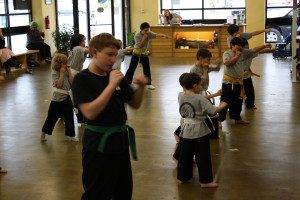By Jennilyn Nelson
Easily one of the most common questions parents of prospective students ask me is: “Will martial arts make my child violent?”. A fully valid question, given the slanted coverage Western media gives to martial arts, and a question I’m always more than happy to answer with a confident “No.”
Where do our ideas about Kids Martial Arts come from?
Many times, a family’s only exposure to martial arts has been through film, TV, or video games. What the viewer/player sees is fight scene after fight scene, a physical display of violence in varying degrees.
The traditional ideas of martial arts teaching discipline, respect and control are seldom portrayed in popular media. Families, then, are left to assume that these concepts are no longer a part of martial arts training, and that martial arts may lead to having physically violent children. Thankfully, these assumptions are wrong – in fact, studies show that kids with traditional martial arts training are more competent, communicative, empathetic individuals and less likely to respond with physical violence in stressful situations.
Kids martial arts are all about preparing for a situation before it happens, getting the body and mind accustomed to the idea of a confrontation and then working our way through appropriate responses. This is obvious in the physical realm: we practice blocks, evasions, strikes, counter-strikes. Some schools, like ours, approach topics such as violence and confrontation directly in conversation, following with discussion on conflict resolution. These discussions help our students to wrap their minds around the “whys” of violence – teach them to consider the perspectives of both attacker and victim, and see the many ways to diffuse a situation without escalating it.
Yet not all conflict resolution lessons are taught verbally in martial arts class. Some of the skills gathered and nurtured in class practice and self-training alike are gleaned by the physical practice of martial movement alone, with little instructor intervention. Skills such as: Focus, emotional deliberation and nonverbal communication skills. How do these skills apply to conflict resolution?
What skills will my child learn in the Kids Martial Arts class?
Focus. In a martial environment, kids are expected to have consistent focus on what they are doing – even in stressful or uncomfortable situations. Holding that horse stance as long as your instructor tells you to doesn’t feel good in the moment; but your focus and ability to calm your mind in that situation rolls over to other tense situations in life.
Emotional Deliberation. In sparring or pair work, kids are exposed regularly to emotions such as apprehension, fear, excitement, mild pain, and adrenaline rush. In these scenarios, kids learn to rank those feelings and decide, in a split second, what feeling to prioritize and then act on that feeling. With proper guidance, young martial artists eventually learn to keep calm at these times, through accepting and moving through these feelings.
Nonverbal Communication. The martial arts also offer kids an opportunity to learn to read verbal and non-verbal cues. Because there is little talking involved in the physical parts of marital arts classes, kids are expected from day one to start interpreting body language as communication. The subtle ways your partner moves, breathes, stands, and facially expresses, are interpreted easier with each class hour. The martial artist begins to take note of how another practitioner “feels” in each moment without any sort of verbal confirmation. In a confrontation, this means a martial artist has an insight into the mood of the group or individual involved. We listen, we stay calm, we respond with minimal escalation of the situation.
In sum, the interdependent nature of martial arts classes gives kids the structure to control both themselves and dangerous situations they may come across. This works conversely as well – should a situation escalate to a point where physical reaction is absolutely necessary, the young martial artist will be adept at using minimal physical force to end the encounter quickly, moving back to verbal tactics, or using the moment to flee the dangerous environment.
Safety and development of conflict management skills of course begin at home – it is the family structure that most forms a youth’s communication skills – but the martial community compliments and enhances this aspect of maturity. Martial arts keeps kids feeling confident, safe and calm, gives them options and makes them less likely to get into physical conflicts. Martial arts prepares kids for the world of high school and beyond – by requiring them to hone their understanding of others and themselves.



